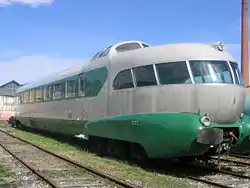FS Class ETR 300
The ETR 300, also known as "Settebello-type" for its use on the former Settebello train service, is a type of Italian fast electric multiple unit (EMU) trainset formerly operated by Ferrovie dello Stato (Italian State Railways).[1] The letters ETR stood for elettrotreno rapido (Italian for high-speed electric train). Thanks to its aerodynamically low-drag profile, it boasted a maximum speed of 200 km/h (120 mph), with a power output of 2600 kW. Manufactured for FS by Breda, a total of only three trainsets were built, numbered ETR 301–303.[2]
| FS Class ETR 300 | |
|---|---|
 Power car of a Class ETR-300 train set in 2006 | |
| In service | 1953–2004 |
| Manufacturer | Breda (now Hitachi Rail Italy) |
| Constructed | 1952 – c. 1958/59 |
| Entered service | 1953–1959 |
| Refurbished | 1991 (only for no.302 train) |
| Number built | 3 trainsets |
| Number preserved | 1 trainset |
| Number scrapped | 2 trainset |
| Formation | Seven-car trainset. |
| Fleet numbers | (ETR-) 301–303 |
| Capacity | 190 ( |
| Operator(s) | Ferrovie dello Stato (FS) |
| Specifications | |
| Maximum speed | 200 km/h (124 mph) |
| Electric system(s) | 3 kV DC Overhead catenary |
| Current collection method | Pantograph |
| Track gauge | 1,435 mm (4 ft 8 1⁄2 in) standard gauge |
History
Since the Italian Railways' high-speed rolling stock got seriously damaged during World War II, the company started developing the project of a new first-class only EMU (ETR, Elettrotreno rapido) which had to be used on the most important long-haul services. The train was built by Società Italiana Ernesto Breda and the first unit, no. 301, was delivered to FS on 21 November 1952. It was nicknamed "Settebello" because of its luxury interior design and furniture and because it was composed of seven cars. The second unit, no. 302, entered service in March 1953, while the last one, no. 303, was launched in February 1959. [2] It started running between Milan and Naples, but in 1955 the service, which offered only 160 first class seats (then the capacity increased to 190 in 1959), was shortened to Rome. The train could reach the speed of 160 km/h (100 mph) and it ran between the terminus in five hours and forty-five minutes. The Settebello was considered one of the symbols of the Italian economical and industrial development and welfare after the war. In 1969 the train was upgraded: new engines (more powerful than the former ones), new boogies and a new safety system were installed in order to make it reach a maximum speed of 200 km/h (120 mph), at which the train never actually ran. On 26 May 1974 the train started operating as TEE "Settebello" as part of the Trans Europ Express network, but the service ended on 3 June 1984 and, from that date, the trainsets were used for less important trains between Milan, Venice, Florence and Genoa. In 1992 the trains were retired from regular passenger service. No. 301 and no. 303 trains were abandoned and scrapped in 1998 in special safety conditions due to presence of asbestos.[3]
The last Settebello
In the early '90s the Italian State Railway had planned a huge refurbishment for the three Settebellos in order to make these trains more safe, technologically-advanced and suitable for Intercity services, but in the end, only no. 302 trainset was converted. All the cars were rebuilt inside: the original furniture designed by Giò Ponti was dismantled and replaced with an ordinary open-space layout; new seats similar to other passenger coaches' ones were installed and the train was divided for the first time into two classes. Many parts of the electrical equipment were replaced with different ones. This refurbishment made the train more modern-looking, but it lost all its historical, elegant furniture, which was one of the most important things to make the Settebello famous in Europe.[4] The converted trainset was not used in regular service, as it had formerly been decided, but for exhibitions and charter services. The ETR 302 was definitely retired in January 2004.[5] it has been abandoned for twelve years near the Adriatic coast of Italy; it has rusted away and it has been heavily damaged by vandals, and many parts are now missing.[6] In August, 2016 the train was rescued by Italian State Railways' Heritage Foundation (Fondazione FS Italiane) and brought to Voghera Workshops; it will be completely restored by rebuilding missing parts and the original furniture, in order to be used as a luxury train for tourist services.[4]
Arlecchino (ETR 250)
Four units of a shorter, four-car version, the ETR 250, called "Arlecchino" ("Harlequin"), were built by Breda in 1960. Those trains had an only first class open space layout, and one of the car was used as a kitchen and baggage car. They were used until 1986, when three of them were refurbished and used for charter services. All the trainsets were scrapped in the late '90s and early 2000s; the surviving unit, no. 252 train, has been restored between 2016 and 2019. Now it's used for tourist trains.[7]
References
- Nock, O.S. (1978). "The Settebello: speed and luxury", in World Atlas of Railways, pp. 118–119. New York: Mayflower Books (original publisher: Artists House, London, UK). ISBN 0-8317-9500-X.
- Innocenti, Marco (20 November 2008). "21 novembre 1952: debutta il Settebello" [21 November 1952: The debut of the Settebello]. Il Sole 24 Ore (in Italian). Milan, Italy. Retrieved 26 February 2013.
- Giampaolo Grilli (2016-04-08), ETR 302 SETTEBELLO - 2016_04_07, retrieved 2016-11-21